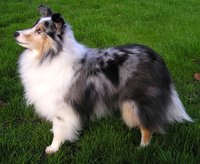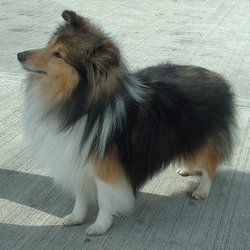Shetland Sheepdog
|
|
| Shetland Sheepdog | |||||||||||||||||
|---|---|---|---|---|---|---|---|---|---|---|---|---|---|---|---|---|---|
| Alternative names | |||||||||||||||||
| |||||||||||||||||
| Country of origin | |||||||||||||||||
| Scotland | |||||||||||||||||
| Classification and breed standards | |||||||||||||||||
|
The Shetland Sheepdog (or Sheltie) is a breed of dog, originally bred to be sheep dogs. It resembles a miniature Rough Collie; as a breed, however, it was not created by miniaturizing (nor is it related to) the Rough Collie.
| Contents |
Appearance
Shelties have a double coat consisting of long guard hairs covering a fluffy insulative undercoat.
Several coat colors exist. There are three main acceptable show colors, sable (ranging from golden through mahogany), tricolor (black, white, and tan) and blue merle (grey, white, black, and tan). Bi-Blues (grey, black, and some white) and bi-blacks (white and black) are less common but still acceptable. The best-known color is the sable ("Lassie color"), although tricolor is also very common. Shelties can also come in red merle, color-headed white (mostly white with some color on the front half of the body), brindle and other colors. However, as these colors are faults in shows, they are quite rare.
The Sheltie's size generally falls in the following ranges:
- Height:
- Males 13-15 inches (33-38cm)
- Females 12-14 inches (30-36cm)
- Weight:
- Males 14-18 pounds (6-8kg)
- Females 12-16 pounds (5-7kg)
Temperament

The Shetland Sheepdog is an outstanding companion dog with a delightful temperament. It is lively, intelligent, trainable, and willing to please and obey. Shelties are usually loving, loyal and affectionate with their family, but suspicious with strangers; for this reason it can be a good watchdog.
The Sheltie is, above all, an intelligent herder and likes to be kept busy. The herding instinct is still very strong in many Shelties. They love to chase things.
Some say males make better and more affectionate pets.
Health
Like the Rough Collie, there is a tendency toward inherited malformation and disease of the eyes. Each individual puppy should have his eyes examined by a qualified veterinary ophthalmologist. Some lines may be prone to hypothyroidism. It can also be affected by displacement of the patella (kneecap), which is thought to be inherited.
Eyes
The two basic forms of inherited eye problems in shelties are SES (Sheltie Eye Syndrome) and PRA (Progressive Retinal Atrophy).
- SES can be detected in young puppies by a certified ophthalmologist. The disease involves all three layers of the posterior eyeball. Mild SES can result in a blind spot, while severe cases will lead to complete blindness.
- PRA can not be detected until later in life, as it is a "progressive" disease. Affected dogs often begin with night vision problems, progressing to loss of day vision and total blindness.
Currently, there is no treatment for either disease.
Note that blue merles commonly have blue eyes and are one of the few dog breeds for which this is normal; for many dogs this is considered a defect.
Ears
Sheltie's ears are required to bend slightly at the tips to be qualified to show in AKC shows. If your dog's ears do not bend, it is acceptable to glue a small fishing-line weight to the tip of the dog's ears. After some time, the weights will fall off and the dog's ears should be in the proper position. There are also several "ear tape" solutions available. It is easiest train your dog's ears when he is very small.
Von Willebrand Disease (vWD)
Von Willebrand disease is an inherited bleeding disorder. In Shelties, affected dogs as a general rule are not viable and do not live long.
Read this article for More information on von Willebrand's in Shelties (http://www.vetgen.com/sheltvwd.html).
Thyroid problems
Hypothyroidism (under-functioning of the thyroid) is being observed more frequently in Shelties. Clinical symptoms include hair loss or lack of coat, over or under-weight, and listlessness. Research is currently ongoing to further understand the thyroid.
History
The Sheltie came from the Shetland Islands off the coast of Scotland. Unlike many miniature breeds that resemble their larger counterparts, this breed was not developed by selectively breeding the Rough Collie for smaller and smaller sizes. Rather, it is the result of the intermingling of possibly several breeds over the past several centuries.
Its exact origins are not known, but the most-often cited ancestors of the breed include the Border Collie (or its ancestors), the Yakki (also Yakkie or Yakkin) dog (a dog kept and bred by Greenland whalers), and the Icelandic sheepdog. During the 19th century, the appeal of small, fluffy dogs became clear, and there are mentions of cross-breedings with Pomeranians (which were larger then than they are today) and with the now-extinct (?) Prince Charles Spaniel or possibly a King Charles Spaniel. Some Shelties in the early 20th century had brindle coats, which could have come from a terrier or Corgi breed. Note: the "mentions" of cross-breedings with Pomeranians is largely seen as a myth by most Sheltie experts.
The year 1909 marked the initial recognition of the Sheltie by the English Kennel Club and the first Sheltie to be registered by the American Kennel Club was "Lord Scott" in 1911.
Miscellaneous
Activities
In their size group, the breed dominates dog agility competitions. They also excel at competitive obedience, showmanship, tracking and herding.
Grooming
Shelties have a double coat. The topcoat consists of long, straight, coarse hair and is used to help repel water. This was necessary because Shelties had to stay dry while herding sheep. The undercoat is short, furry, and very dense in order to help keep the dog warm. The Sheltie is usually a clean dog and should only need to be brushed once or twice a week (it is helpful to spray-mist with water when brushing). Mats can be commonly found behind the ears, under the elbow on each front leg, and in the rear ('hawks').
Toenails and hair between the pads need to be trimmed every couple of weeks.
If you are showing your dogs in showmanship or obedience, you might need to brush the dog's fur more often. Doing so will not adversely affect the dog and may improve your score. One recommendation for a show dog is to brush it twice a week until a week before the show, then brush it every day up to the show.
Most Shelties learn to love the attention that grooming provides, if the routine is started when the dog is still young.
Dog Pictures and Clipart
- Pictures of Dogs (http://classroomclipart.com/cgi-bin/kids/imageFolio.cgi?direct=Animals/Dogs)
- Dog Clipart (http://classroomclipart.com/cgi-bin/kids/imageFolio.cgi?direct=Clipart/Animals/Dog_Clipart)
Clipart and Animal Pictures
- Clipart (https://classroomclipart.com/image/category/clipart.htm)
- Animal Clipart (https://classroomclipart.com/image/category/animal-clipart.htm)
- Animal Animated Clipart (https://classroomclipart.com/clipart/Animations/Animals.htm)
- Pictures of Animals (https://classroomclipart.com/image/category/animal-photos.htm)
- Amphibian Clip Art, Pictures and Photogaphs (https://classroomclipart.com/image/category/amphibian-clipart.htm)
- Farm Animal Clip Art, Pictures and Photographs (https://classroomclipart.com/image/category/farm-animal-clipart.htm)
- Mammal Clip Art, Pictures and Photographs (https://classroomclipart.com/image/category/mammal-clipart.htm)
- Marine Animal Clip Art, Pictures and Photographs (https://classroomclipart.com/image/category/marine-life-clipart.htm)
- Reptile Clip Art, Pictures and Photographs (https://classroomclipart.com/image/category/reptile-clipart.htm)
- Spider Clip Art, Pictures and Photographs (https://classroomclipart.com/image/category/spider-clipart.htm)



